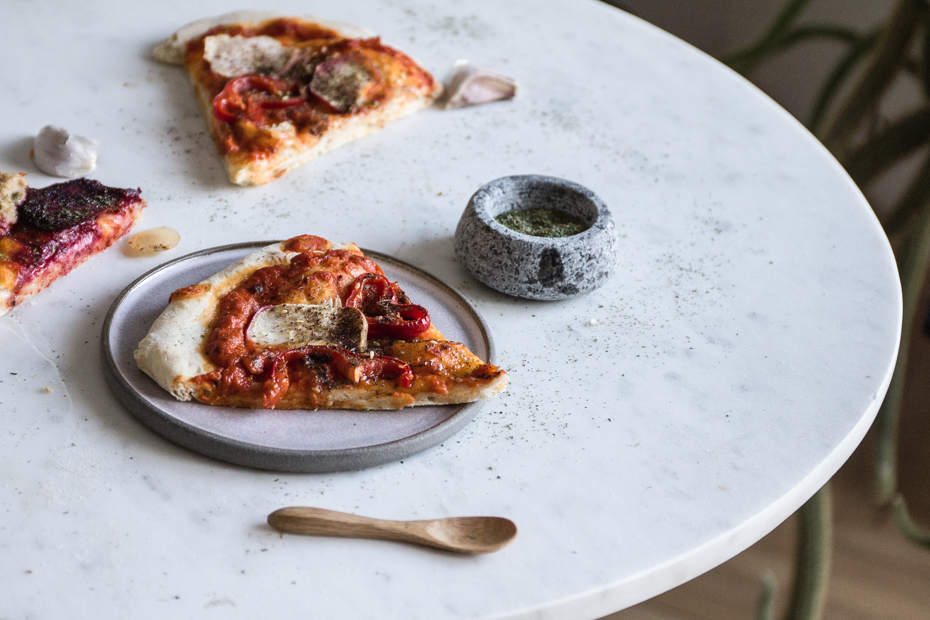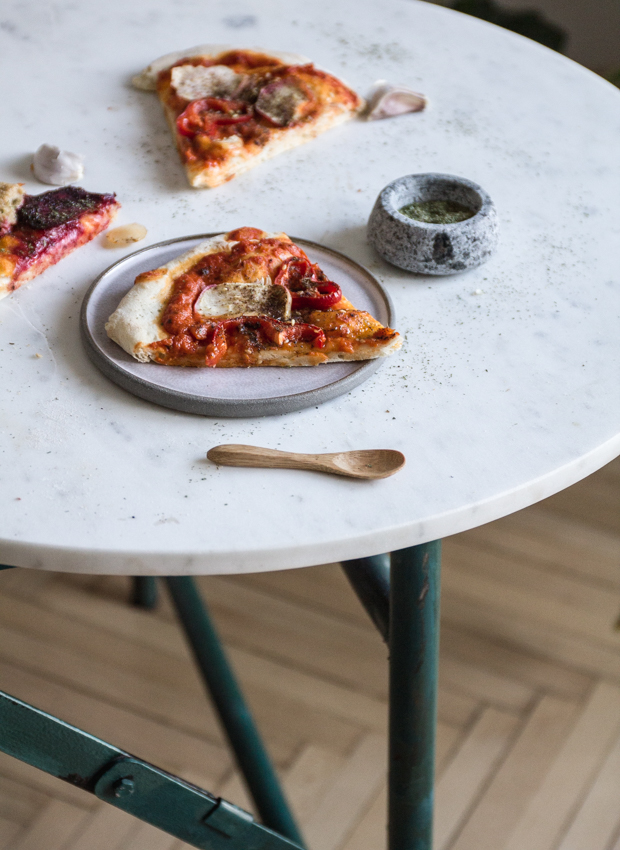
Searching for a perfect, home-made pizza recipe is not an easy job. Maybe because there is no such thing. Every cook has his/her own way to make pizza and every pizza eater has his/her favourite one to consume. Some may enjoy classics like thin napoletana, some may crave for more modern, American thick version. Among thousands of recipes, ideas and tips, it is truly a challenge to find this perfect one.
For me, home-made pizza should be quite thin, crispy with minimal amount of toppings. Sometimes I add a bit of semolina to get more crunchy one. So my preferences lean more to napoletana style, though I cannot lie, the home-made version bear only some resemblance of original one.
The begging of prefect pizza dough journey is quite pleasant. You search for an easy and popular recipe on the web, ask friends for advice. It seems casual and not complicated at all. The pizza tastes good, but something tales you to keep searching. You start to read cookbooks. I’ve tested and analysed recipes from many books, I’ve also read a lot of blogs. Neither Silver Spoon, nor Jamie Olvier and Hammelman have reached my expectations. My recipe for home-made pizza is based on the one from ‘Professional Chef’ cookbook. Since I created my own recipe I’ve been trying some new and old ones, but I find this one the best.
Doing a pizza research I’ve come to some conclusions. There is no need to play full Italian when it comes to make home-made pizza. Some recipes ask just too much: too much effort, too many rules, too much sticking to the tradition. And when you are asked to follow all those rules, it’s not fun any more.

Few helpful pizza basics:
Flour and proportions:
In a pizza recipe, besides the flour to water ratio, the important thing is a type of flour you use.
My favourite one is type 550. Making dough using farina (typical, classical and usually recommended for making pizza) is really difficult for me and the effect is not good enough. I don’t know why, because according to the books it is the best flour for pizza. But don’t let my bad experience with farina (also called 00 type) hold you from using it. I may be the perfect one for you.
Remember when testing types of flour, they may require different amounts of water. The differences are rather small, but quite substantial.
Adding semolina will make your pizza more crispy. I promise to share the recipe for semolina pizza dough some day.

Yeast:
I use dried ones, but of course you can choose fresh. For me there is no big difference, but when you check on the web, you will find plenty pros and cons on both types. Just remember this:
1 tsp dried yeast weight about 3 g
7 grams of dried yeast (usually one package)= 15 grams of fresh yeast
Yeast, flour, water and more…
By more I mean salt, olive oil and sugar. Some, especially fans of tradition will tell you: ‘no help for yeast, stick to the basics: flour, water, salt and yeast’. This time I agree with them, but I also add 1 tbsp olive oil to my dough (seriously, I don’t know why). To other ingredients like milk, sugar, eggs, I said no.
Using a food processor
Because I don’t have food processor that can mix the dough I do it manually. Some might say that pizza dough can be made only by hands (‘the warmth of human hands etc…’). But if you have equipment at home, why not try?
The kneading part
At the beginning I was trying really hard to knead my dough exactly like the recipe says. I even checked the gluten formation (weirdo). But all those efforts didn’t influence the pizza taste or shape at all. But there was no fun in making such pizza. So I quit those weird practices.
Now I knead as long as the dough become smooth, but still little sticky. It should get off hand easily, with not many leftovers.
Fermentation:
After kneading fermentation stage starts. I leave the dough in warm place for about one hour. Don’t worry it can be longer. After about 1 hour, you knead the dough one again few times and let it rest for another 15 minute. You can start to from a pizza now. You can also put the dough to a fridge overnight or even longer to start next fermentation called cold one.
I usually keep the dough for 24 hours in the fridge and take it out about 2 hours prior to baking. Cold fermentation slows the yeasts and more gluten is formed. The pizza from cold fermentation differs a little in structure. It’s lighter and develop more bulbs. If you want to read (and also see) more about cold fermentation and its influence on dough check this page.
Of course sometimes when I need to eat pizza right away or forget to plan, I skip the cold fermentation and it’s delicious anyway.
How to form a round shape:
It’s a difficult job. Of course traditionally, you should shape it with your hands. You need a lot of practice to do it right, though. There is even harder to work with the dough which fermented in the fridge. My pizzas shaped by hands are always crooked and a bit thicker than I want.
There is a rule that you should never ever roll the dough. But recently I’ve decided to break this one. And the pizza was perfect, thin, with more bulbs. So now I’m all about rolling.
Baking:
Preheat the oven to maximum temperature (mine is about 250C). I used to bake pizza on the stone. The effects were of course delicious, but the baking tray (flipped upside down) is far easier to use and keep. I read somewhere that flipping the tray makes the air flow more like in a real oven (but I don’t know if its true). Anyway, I bake on flipped tray, slightly floured and so far I’m sticking with this method. If you don’t want to buy a pizza stone or you have no place to store it, the tray will be a perfect choice for you.
I bake pizza for about 7-8 minutes heating from top and bottom, sometimes the last 1 minute I switch to circulation. It all depends on the oven, so you need to watch your pizza carefully for the first few times, then you’ll know the drill.


The basic sauce and toppings:
In this post I include the recipe for my favourite basic pizza sauce. It’s really simple, but always works. In addition, I also share a recipe for almond ‘cheese’, which tastes delicious especially when paired with beets.
I adore minimal topping pizzas. My favourites are artichokes, capers, beets, olives, ramiro bell peppers, arugula, fresh spinach, hot peppers. Those on the photos are with beets and almond cheese, and the second is with peppers and apples, sprinkled with winter savory spice blend.

Home-made pizza recipe:
2 large PIZZas or 3 medium-sized
Ingredients:
650G flour type 550
400 ML lukewarm water
3 G dried yeast (1 tsp)
1 1/2 tsp salt
1 tbsp olive oil
Instructions:
- Mix the flour and salt. Dissolve the yeast in lukewarm water.
- Knead the dough until the it is soft and elastic. It should be slightly sticky. At the end of kneading, add olive oil. Place in olive oil-covered bowl and set aside for about 1 hour.
- Knead again, but only few times and let it rest for another 15 minutes.
- Then you either bake it or place the dough in the refrigerator for 24h(look above in Fermentation). If we decide to do the second fermentation (the cold one), remember to remove it from the refrigerator 2 hour prior to baking.
- Preheat the oven to maximum temperature (with baking tray inside). Divide the dough into 2 or 3 parts. Form the dough in a thin round. You may use a roller or form the dough with your hands.
- Place shaped dough on the floured baking tray, remember that the tray is hot (you can use the flipped method I describe above). Put the sauce and the toppings and place the tray in the oven.
- Bake 7-8 minutes. I use top and bottom heating option, sometimes I turn to circulation for the last 1 minute. Every oven bakes differently, so watch carefully for first few times. Your pizza might need more or less baking time.


Basic tomato Pizza sauce:
for 2 large or medum pizzas
Ingredients:
1 can of tomatoes or about 500g fresh, skin removed
½ small onion
1 garlic clove
2 tbsp olive oil
13-15 basil leaves
salt and pepper
Instructions:
In a medium pot, heat the olive oil. Add chopped onion and cook, stirring occasionally (on a low heat) about 10 minutes, until soft and slightly golden. Add chopped garlic and sauté another minute. Pour in tomatoes and cook on a low heat for 30-40minutes. At the end of cooking add the basil leaves, season with salt and pepper. Blend if needed.

Almond ‘cheese’
ingredients:
100g almond in flakes
100 ml soy milk
white wine vinegar
lemon juice
salt and pepper
Instructions:
Blend almond with milk. Season with vinegar or lemon juice, salt and pepper.







